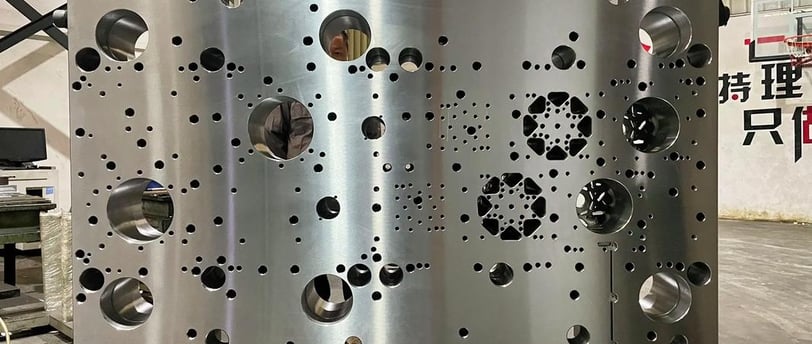Cutting and Punching Technology in Stamping Dies in Detail
1/31/2025


Introduction to Stamping Dies
Stamping dies are essential components in the manufacturing sector, particularly within metalworking processes. These tools, used in stamping operations, facilitate the shaping, cutting, and forming of metal sheets into precise parts that meet specific industry requirements. The fundamental principle behind stamping is to manipulate metal into desired shapes using the force from a press machine, which can exert significant pressure. This process is crucial in producing high volumes of components with consistent quality, especially in industries such as automotive, electronics, and appliances.
There are several types of stamping dies, each designed for particular purposes. Progressive dies, for example, are utilized in processes where multiple operations are performed in a single cycle, allowing for efficient production of complex parts. Other types include compound dies, which perform multiple operations in one stroke, and transfer dies that move the metal part from one station to another for subsequent operations. The choice of die type is determined by the complexity of the desired part, material thickness, and production volume.
Within the domain of stamping, cutting and punching methods play a pivotal role. These techniques ensure that metals are accurately shaped according to design specifications. Cutting refers to the removal of material to form desired profiles, while punching describes the process of creating holes or indentations in the metal. The precision of these methods is vital, as any inaccuracies can affect the overall functionality of the finished product. The integration of cutting and punching into stamping die operations not only enhances the efficiency of metalworking but also contributes to the reduced waste of materials, showcasing the importance of these technologies in modern manufacturing processes.
Different Cutting Techniques in Stamping Dies
Stamping dies incorporate a range of cutting techniques, each with distinct characteristics, advantages, and applications. Understanding these methods is crucial for optimizing production processes and achieving precision in machining various materials. Four prominent cutting techniques used in stamping dies are shearing, laser cutting, water jet cutting, and traditional machining.
Shearing is a widely adopted method that utilizes a shear force to cut through materials. This technique is favored for high-speed production and is particularly effective for sheet metals. The primary advantage of shearing is its capability to handle thin materials with minimal wastage. However, it may not suit thicker or harder materials, which require more robust cutting solutions.
Laser cutting offers exceptional precision by employing high-intensity laser beams to melt or vaporize materials. This technique is particularly advantageous for intricate designs and complex shapes. The primary benefits of laser cutting include minimal material distortion, reduced kerf width, and the ability to process a wide range of materials, including both metals and plastics. Nevertheless, the initial investment in laser cutting technology can be significant, although it yields high-quality results over time.
Water jet cutting is another versatile method that utilizes high-pressure streams of water, often mixed with abrasives, to cut through hard materials. This technique excels in preserving the material's integrity, as it generates negligible heat, thus minimizing thermal deformation. Water jet cutting is especially suited for materials that cannot withstand high thermal input, such as glass, composites, or sensitive electrical components. The ability to cut thicker materials, combined with its eco-friendly nature, makes water jet cutting an increasingly popular choice.
Traditional machining encompasses a range of processes, including milling and turning, which employ cutting tools to shape materials mechanically. While this method allows for high precision and is suitable for various materials, it often involves more labor-intensive operations and potentially higher material wastage compared to the previously mentioned techniques.
Each cutting technique has its unique strengths and limitations, making it imperative for professionals to choose the most efficient method based on material specifications and desired outcomes in stamping die applications.
Punching Technology and Its Applications
Punching technology is a critical aspect of stamping dies, enabling the precise cutting and shaping of materials for various industrial applications. The punching process involves the use of punches and dies to create holes or shapes in a workpiece, which is typically metal. The mechanism is both efficient and versatile, allowing manufacturers to produce high volumes of parts with consistent precision. Understanding the different types of punches available, including standard, compound, and progressive punches, is essential for selecting the right technology for specific projects.
Standard punches are the most commonly used type, characterized by their simplicity and straightforward design. They are particularly effective for single-operation applications where only one cut is necessary. However, for more complex operations involving multiple cuts or shapes, compound punches are often preferred. These tools integrate multiple cutting actions into a single setup, significantly improving efficiency and reducing production time. This multi-functional capability makes compound punches ideal for high-volume manufacturing scenarios.
Progressive punches take efficiency to the next level by allowing sequential operations in one continuous process. This technology involves feeding the material through a series of stations, each performing a specific cut or shape. As the material moves through the die, progressive punches create parts with intricate designs while maintaining high throughput levels. This method is especially beneficial for large-scale production, where time and cost savings are paramount.
When designing punches, several factors should be considered, including punch geometry, material selection, and the specific requirements of the application. The choice of punch material is crucial, as it affects durability and performance under varying operational conditions. Additionally, the impact of process parameters, such as speed and pressure, plays a significant role in the effectiveness of punching operations. Optimizing these parameters can lead to improved product quality and reduced wear on punching tools. By strategically selecting and designing punches, manufacturers can enhance productivity and achieve superior results in their stamping operations.
Future Trends in Stamping Die Technologies
The landscape of cutting and punching technologies within stamping dies is experiencing a paradigm shift, driven by continuous advancements in automation and smart technology integration. Stamping die manufacturers are increasingly adopting automated systems to enhance production efficiency and precision. Automation not only helps in reducing labor costs but also minimizes human error, leading to improved product quality. The implementation of robotics in the manufacturing process enables faster cycle times and higher output, which are critical for meeting the growing demand in various industries.
In tandem with automation, the incorporation of smart technology has become paramount in the evolution of stamping dies. The Internet of Things (IoT) allows for real-time monitoring and data collection during the stamping process. Analyzing this data can lead to immediate adjustments and optimization of production efficiency. Moreover, smart sensors embedded within the dies can detect anomalies and predict maintenance needs, thereby reducing downtime and ensuring consistent operational performance.
Another significant trend is the integration of artificial intelligence (AI) in die design and production. AI algorithms can analyze substantial datasets to optimize die geometries and material selection, tailoring designs to meet specific production requirements. This technology paves the way for more innovative and efficient stamping processes, enabling manufacturers to remain competitive in a rapidly evolving marketplace.
Despite these advancements, the industry faces challenges such as the need for skilled labor capable of operating these advanced systems and the initial investment costs associated with new technologies. However, these hurdles present opportunities for innovation, particularly in developing training programs that prepare the workforce for the future.
Lastly, sustainability is becoming an integral aspect of stamping die manufacturing. Companies are focusing on eco-friendly practices, including the use of recyclable materials and energy-efficient machines. Embracing these sustainable practices not only reduces environmental impact but also aligns with the global shift towards greener manufacturing solutions.
